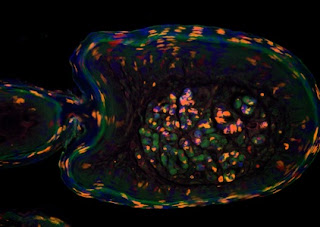 |
| Regenerated mouse digit tip/Yuval Rinkevich |
Guest blogger Uta Grieshammer is a science officer at CIRM
A form of regeneration that has captured the imagination of scientists and the general public for many decades occurs in certain salamanders, as they have the remarkable ability to regrow a severed leg. Leg regeneration is unusual not only because it is so rare among vertebrates, but also because the underlying mechanism is thought to be quite different from that operating during the regeneration of organs in mammals.
Although mammalian legs do not regenerate, the very tips of our fingers and toes, and those of mice, do sometimes regrow. A new study published August 24 in Nature from Irv Weissman’s lab at Stanford University, and partially funded by CIRM, now comes to the surprising conclusion that the mechanism at work during mouse digit tip regeneration more resembles that of our other organs rather than the way that salamanders’ legs have been thought to regrow.
Although it may not be obvious, many of the organs in a healthy person regenerate themselves throughout life, some more than others. Our whole blood forming system and our gut, for instance, turn over relatively rapidly, whereas only about half of our heart cells are replaced in our entire life. Some organs, such as our skin, muscles, and bones, also have a reasonable capacity for repair after injury, if the damage was relatively small, while much of our liver will be faithfully replaced after a large portion has been removed. Other organs, though, replace cells lost to insult or disease only poorly or not at all, such as the heart following a heart attack. The hope is, if we figure out how the regeneration superstars of our body, or those of salamanders, accomplish their remarkable feats, we can use that knowledge to coax their less talented brethren into action.
Scientists have three basic models for how regeneration occurs: 1) tissue-specific stem cells within the organ divide and mature into the additional tissue, 2) mature cells divide to produce more of themselves without contributing to other cell types, or 3) mature cells lose their specificity, become more like embryonic cells and form a blastema with the ability to divide and form the original cell type and also other cell types in the regenerating tissue.
Weissman’s work with postdoctoral scholar Yuval Rinkevich, who was first author on the paper, shows that during digit regeneration in mice, the third model is not the right one. Remaining skin cells only make new skin cells, bone cells only make new bone. This comes a bit as a surprise, as this appears to be very different from the blastema mechanism thought to be used by salamanders to regrow their limbs. However, recent experiments from Elly Tanaka’s group in Dresden have challenged that long held model, showing that blastema cells in regrowing salamander legs do not typically adopt fates different from those of the cells they’re derived from. These studies then suggest that regeneration of limbs and digits in salamanders and mice, respectively, does occur through related mechanisms, just not the one originally thought. In both cases, repopulating cells do not switch cell fate, but whether regenerated digit or limb cells are derived from tissue-specific stem cells or from mature cells remains an open question for both species, although the Weissman paper makes a cogent argument that their data are consistent with the stem cell model, at least for some of the cell types involved in mouse digit regeneration.
Concerted efforts by scientists studying animals such as salamanders and mice will likely lead to an ever more accurate picture of limb and digit regeneration, thereby laying the groundwork for translating these findings to human cells, and eventually to human treatments.
CIRM funding: Irv Weissman (RC1-00354)
Nature, August 24, 2011



